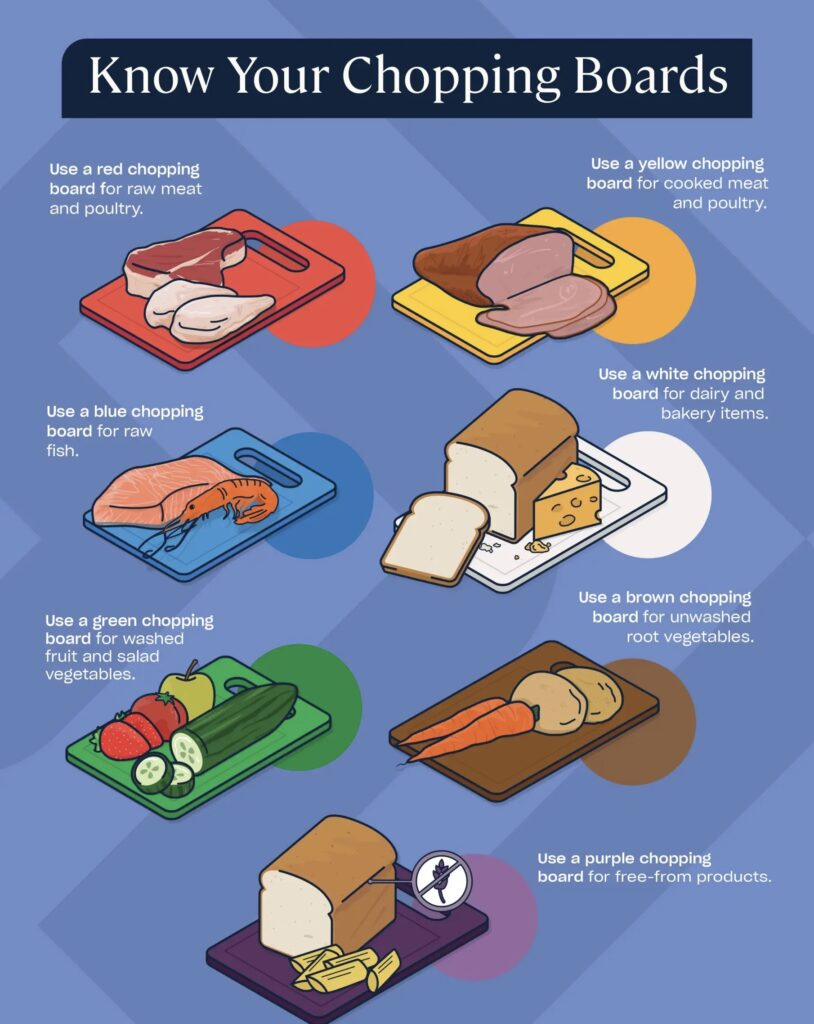What are the Types of Chopping Boards and How are they Used?
The different chopping board colours exist for the purpose of food safety. In a coloured chopping board system, each board is used for a different type of food or food groups. For example, a red chopping board has a different use to a green chopping board.
Using coloured boards helps to minimise the risk of cross-contamination by ensuring that high and low risk foods, such as raw meat and salad vegetables, are kept separate. In turn, this helps to prevent outbreaks of food poisoning and upholds a good business reputation.
As well as this, coloured boards also help to prevent cross-contact between allergens. For example, using different boards for dairy-free and dairy cheeses can help to keep dairy allergy sufferers safe and maintain their confidence in your food establishment.
- Red Chopping BoardA red chopping board is used for raw meat and poultry. Examples of when you would use this board include to cut up meat prior to cooking it, to marinate meat, or to debone a piece of meat.You must use this board whenever you need to work with raw meat. This is essential for preventing cross contamination between raw meat and ready-to-eat foods.
-
Yellow Chopping Board
A yellow chopping board is used for cooked meat and poultry. For example, cooked meats like ham, salami, and turkey slices. Meat that you have cooked and that you’d like to slice or debone, such as a joint of beef or a whole chicken, are also included.
The yellow chopping board must only be used for cooked meat. Raw meat must be prepared separately, on the red chopping board, to avoid cross-contamination.
If you need to cut or prepare cooked fish, such as slicing a salmon fillet or deboning a piece of trout, then you should also use the yellow chopping board. However, you should not use it for raw fish.
-
Blue Chopping Board
You should use a blue chopping board for raw fish, including shellfish. For example, you would use it for fish such as cod, haddock, and pollock, for oily fish such as tuna, salmon, and mackerel, and shellfish such as prawns, squid, and mussels.
-
White Chopping Board
A white chopping board is used for dairy and bakery items. This means you can use it for cutting bread, cakes, and pastries. You can also use it for dairy items such as grating or cutting cheese.
You should always remember to wash your chopping boards between uses and especially when you have had food on them that contains an allergen. It could be fatal to prepare bread on an unwashed white board that you used for cheese, for example.
-
Green Chopping Board
A green chopping board is used for washed fruits and salad vegetables. You should use this board for cutting up fruit, such as apples, bananas, and strawberries, and when cutting up salad items, like tomatoes, peppers, and cucumber.
Brown Chopping Board
A brown chopping board should be used when you are handling unwashed root vegetables. For example, when you are cutting potatoes, grating carrots, or slicing beetroot. Root vegetables often still have soil on them, so using a brown chopping board helps to ensure that this dirt doesn’t come into contact with other food.
- Purple Chopping Board
- You should use a purple board for preparing free-from products, such as gluten-free bread. Not only is this good practice, but it could also prevent a fatal reaction for people who suffer with allergies. It’s essential that you take steps to prevent cross-contact and allergic reactions




Recent Comments